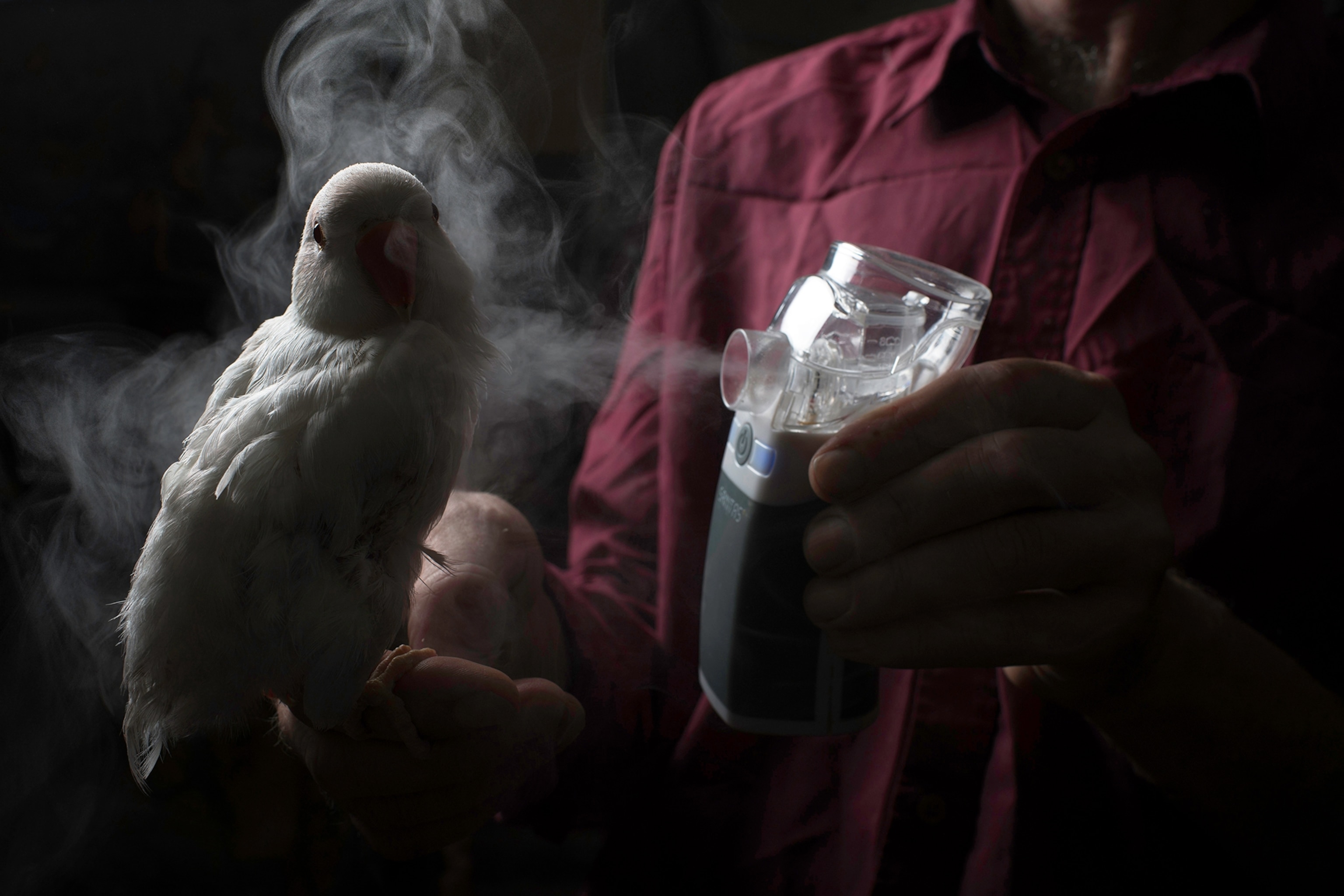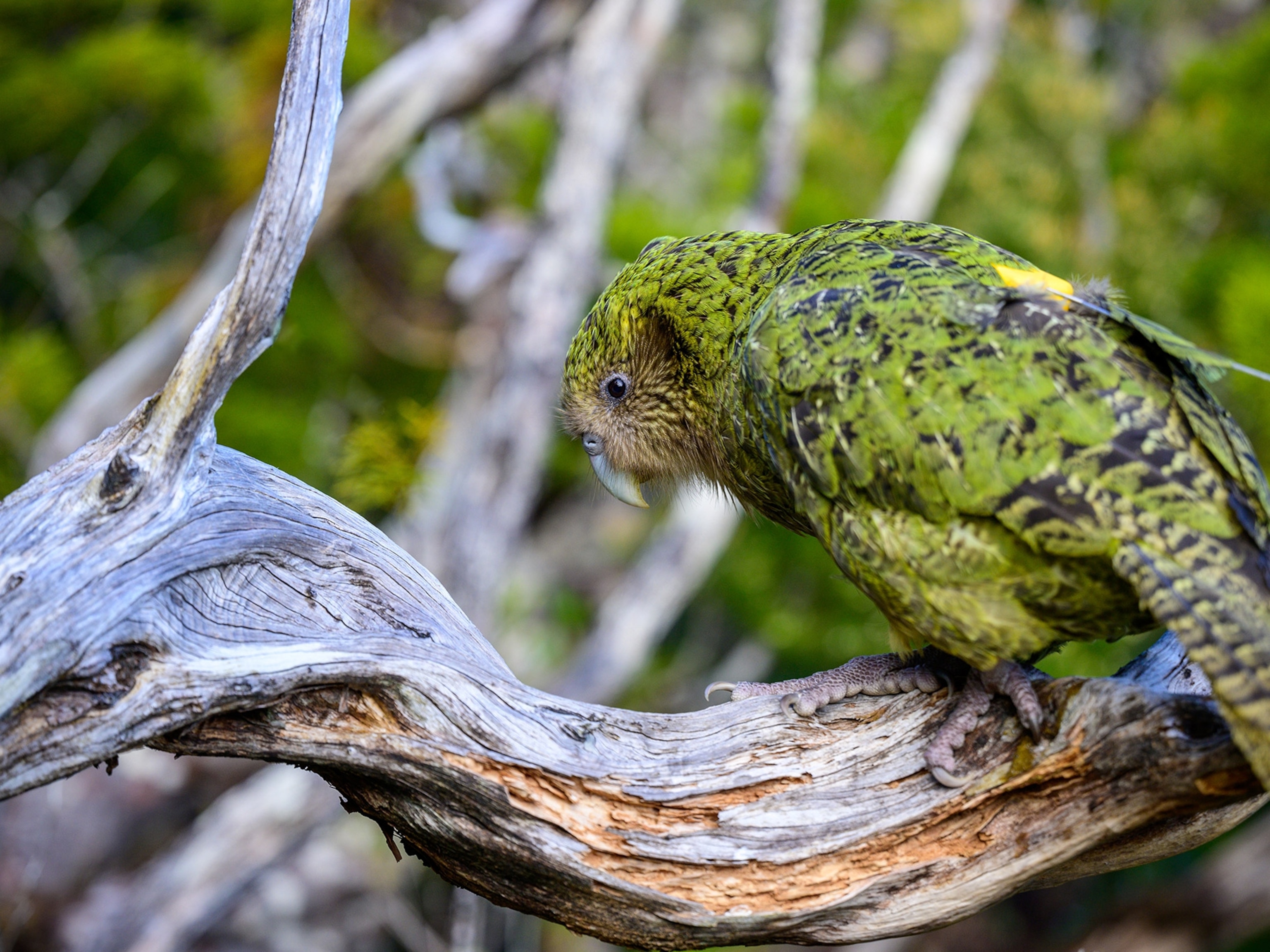When firefighter Brian Wilson retired in 1995, he planned to fill his days teaching fire and public safety classes to children. He liked to bring along his three parrots for these public appearances; he found the birds were a crowd-pleasing way to deliver the message. He even taught his green-winged macaw, Rocco, to stop, drop, and roll.
But a devastating car accident left Wilson with serious and permanent injuries that upended his life as well as his retirement plans. He has since regained his ability to walk and talk, and he credits his birds with the progress he’s made.

“My parrots rehabilitated me,” Wilson says. “With what they did for me, I want to rescue every bird I can and make them the happiest birds in captivity.”
Today, Wilson runs a nonprofit parrot sanctuary in Maryland, where he rehabilitates unwanted parrots. He provides a home to 36 of the large, intelligent birds and adopts others out.




Wilson is one of three human subjects who appear in photographer Miisha Nash’s series, “The Wild Ones.” Nash began photographing parrots and their caretakers in 2014, documenting people in the United Kingdom and the United States who share their lives with dozens of the birds.
“I found this subculture of people who were taking in parrots that were once pets but needed to be rehomed and creating these sanctuaries for them,” Nash says. “Originally, I wanted to photograph only the parrots. But then the people I was meeting were all such characters!”



Parrot problems
The allure of parrots is understandable: They are beautiful, intelligent, and social creatures. They can learn tricks and be cuddly with trusted people. So why the need for rescues?
Parrots, especially those that have not been properly socialized and trained, can be destructive, messy, and loud. They require lots of attention and consistent daily care. After the novelty wears off and owners realize the level of responsibility required for such an animal, many birds end up in need of a new home.

Another issue is the simple fact that many parrots outlive their owners. Large amazons and macaws, for example, can live to be 100 years old.
In these cases, rescues are often in order. But moving from home to home and owner to owner can be traumatic for the sensitive birds. Some parrots arrive at sanctuaries with plucked-out feathers or behavioral issues.
“They are damaged, hurt beings,” Nash says. “The people who take on that responsibility are doing a good thing, because the need for it is a byproduct of humans wanting to own birds.”
Going to the birds
Nash says her human subjects share some traits, like extraordinary patience and a strong sense of empathy for other creatures.
Rescuing and caring for unwanted birds can seem selfless, but Nash also sees these birds fulfilling psychological needs for their caretakers.
“I think it is a way to have an intimate relationship that you can control,” Nash says. “These birds are totally dependent on their caretakers for all their needs. The caretakers of parrots are probably attracted to the service aspect of it, too, and enjoy the feeling of being needed.”

Caring for dozens of parrots is a labor of love that requires complete devotion. Yet, caretakers like Wilson say it’s a joy to be able to care for these birds.
“When you give a bird everything it wants,” he says, “they give it back to you tenfold in love.”
Nash calls “The Wild Ones” a love story. The series is about who we, as humans, choose to love and how. It is about our love of beauty and the exotic—a love that sometimes drives us to put birds in cages.
“It turned out to be about how humans love other creatures, but only conditionally,” Nash says. “But when a parrot loves someone, it loves that person unconditionally.”

You May Also Like
Go Further
Animals
- Octopuses have a lot of secrets. Can you guess 8 of them?
- Animals
- Feature
Octopuses have a lot of secrets. Can you guess 8 of them? - This biologist and her rescue dog help protect bears in the AndesThis biologist and her rescue dog help protect bears in the Andes
- An octopus invited this writer into her tank—and her secret worldAn octopus invited this writer into her tank—and her secret world
- Peace-loving bonobos are more aggressive than we thoughtPeace-loving bonobos are more aggressive than we thought
Environment
- U.S. plans to clean its drinking water. What does that mean?U.S. plans to clean its drinking water. What does that mean?
- Food systems: supporting the triangle of food security, Video Story
- Paid Content
Food systems: supporting the triangle of food security - Will we ever solve the mystery of the Mima mounds?Will we ever solve the mystery of the Mima mounds?
- Are synthetic diamonds really better for the planet?Are synthetic diamonds really better for the planet?
- This year's cherry blossom peak bloom was a warning signThis year's cherry blossom peak bloom was a warning sign
- The U.S. just announced an asbestos ban. What took so long?The U.S. just announced an asbestos ban. What took so long?
History & Culture
- How technology is revealing secrets in these ancient scrollsHow technology is revealing secrets in these ancient scrolls
- Pilgrimages aren’t just spiritual anymore. They’re a workout.Pilgrimages aren’t just spiritual anymore. They’re a workout.
- This ancient cure was just revived in a lab. Does it work?This ancient cure was just revived in a lab. Does it work?
- See how ancient Indigenous artists left their markSee how ancient Indigenous artists left their mark
- Why Passover is one of Judaism’s most important holidaysWhy Passover is one of Judaism’s most important holidays
- Is this mass grave a result of contagion—or cannibalism?Is this mass grave a result of contagion—or cannibalism?
Science
- This 80-foot-long sea monster was the killer whale of its timeThis 80-foot-long sea monster was the killer whale of its time
- Every 80 years, this star appears in the sky—and it’s almost timeEvery 80 years, this star appears in the sky—and it’s almost time
- How do you create your own ‘Blue Zone’? Here are 6 tipsHow do you create your own ‘Blue Zone’? Here are 6 tips
- Why outdoor adventure is important for women as they ageWhy outdoor adventure is important for women as they age
Travel
- Slow-roasted meats and fluffy dumplings in the Czech capitalSlow-roasted meats and fluffy dumplings in the Czech capital
- Want to travel like a local? Sleep in a Mongolian yurt or an Amish farmhouseWant to travel like a local? Sleep in a Mongolian yurt or an Amish farmhouse
- Sharing culinary traditions in the orchard-filled highlands of JordanSharing culinary traditions in the orchard-filled highlands of Jordan





